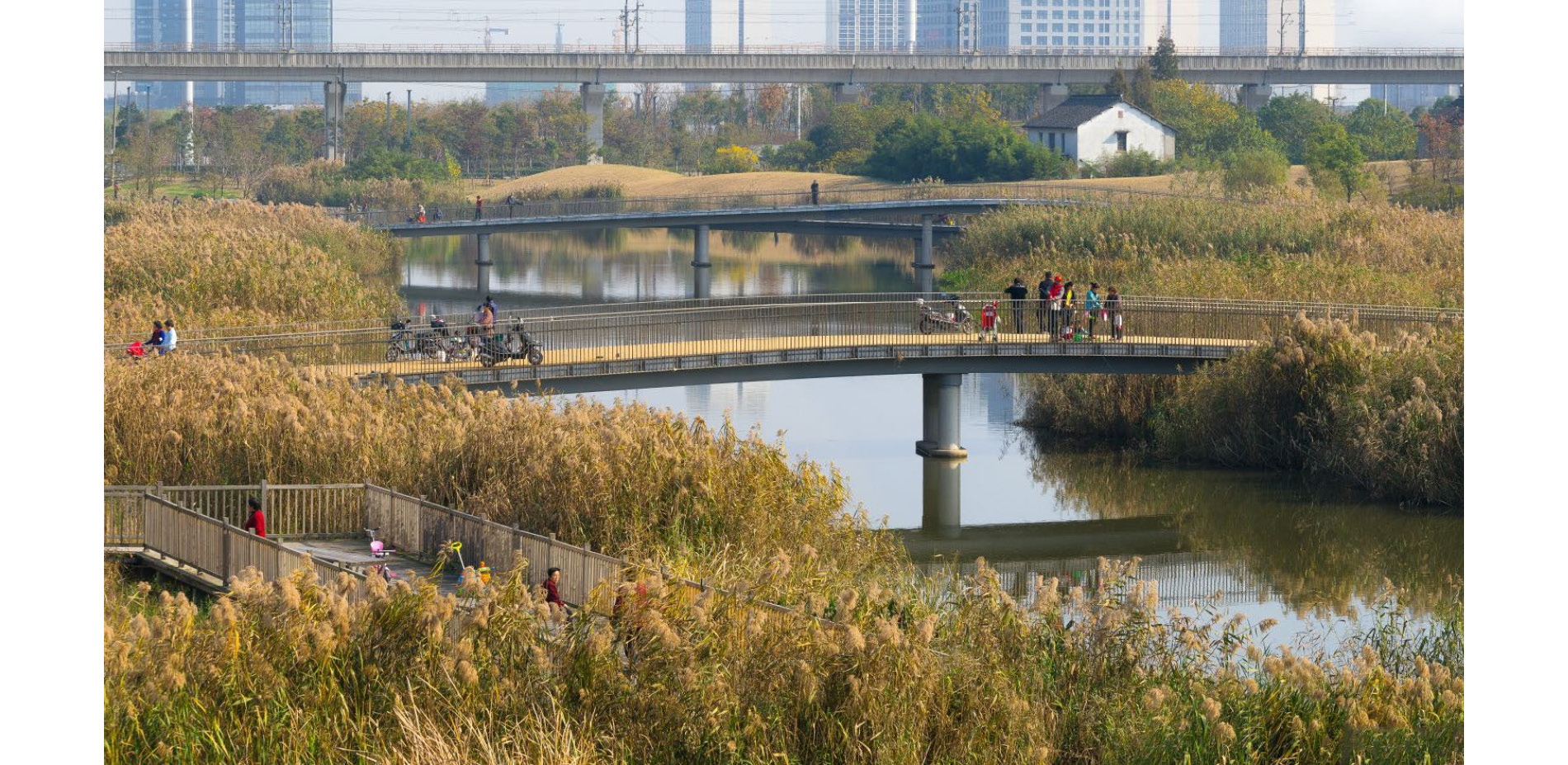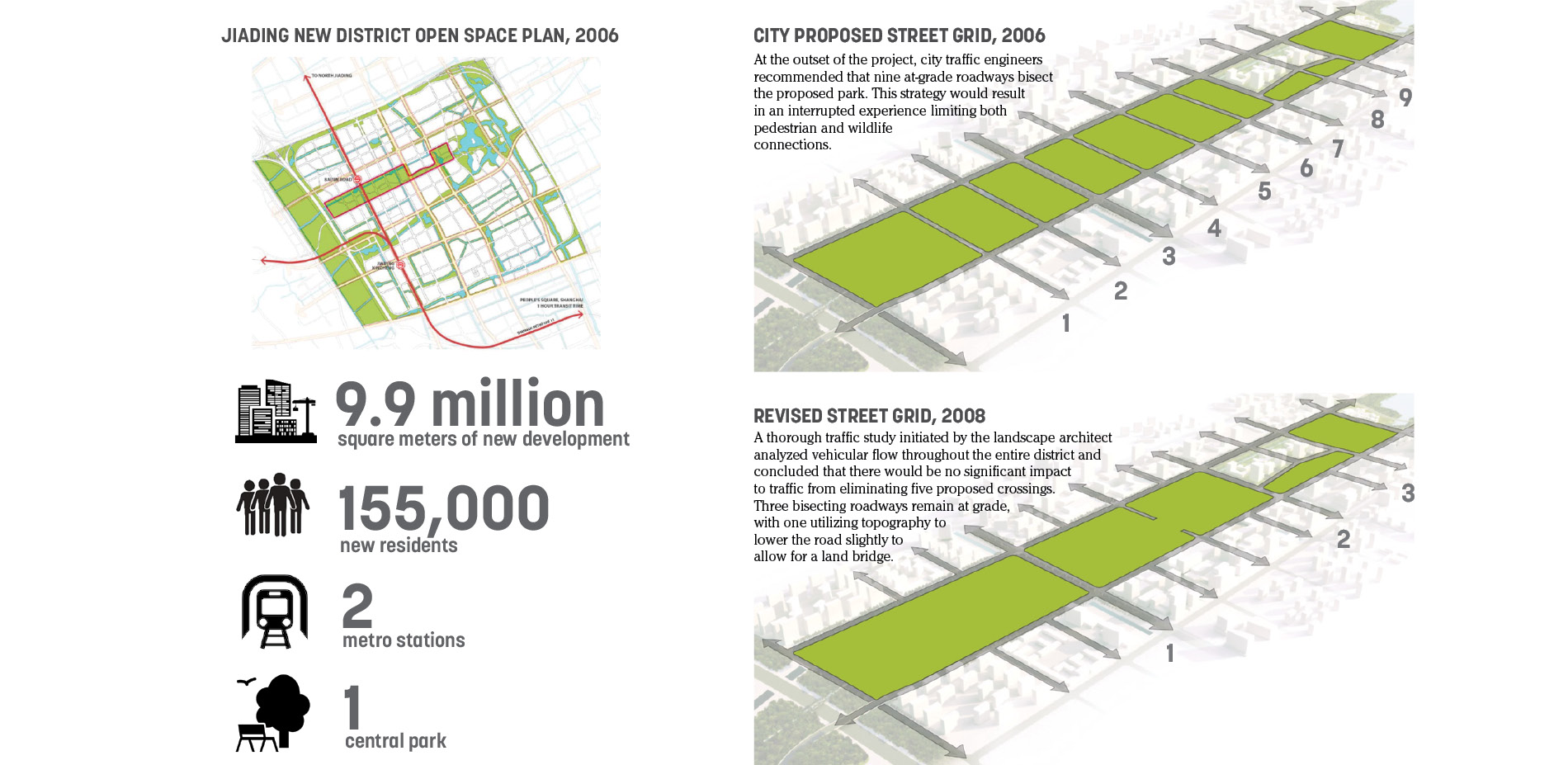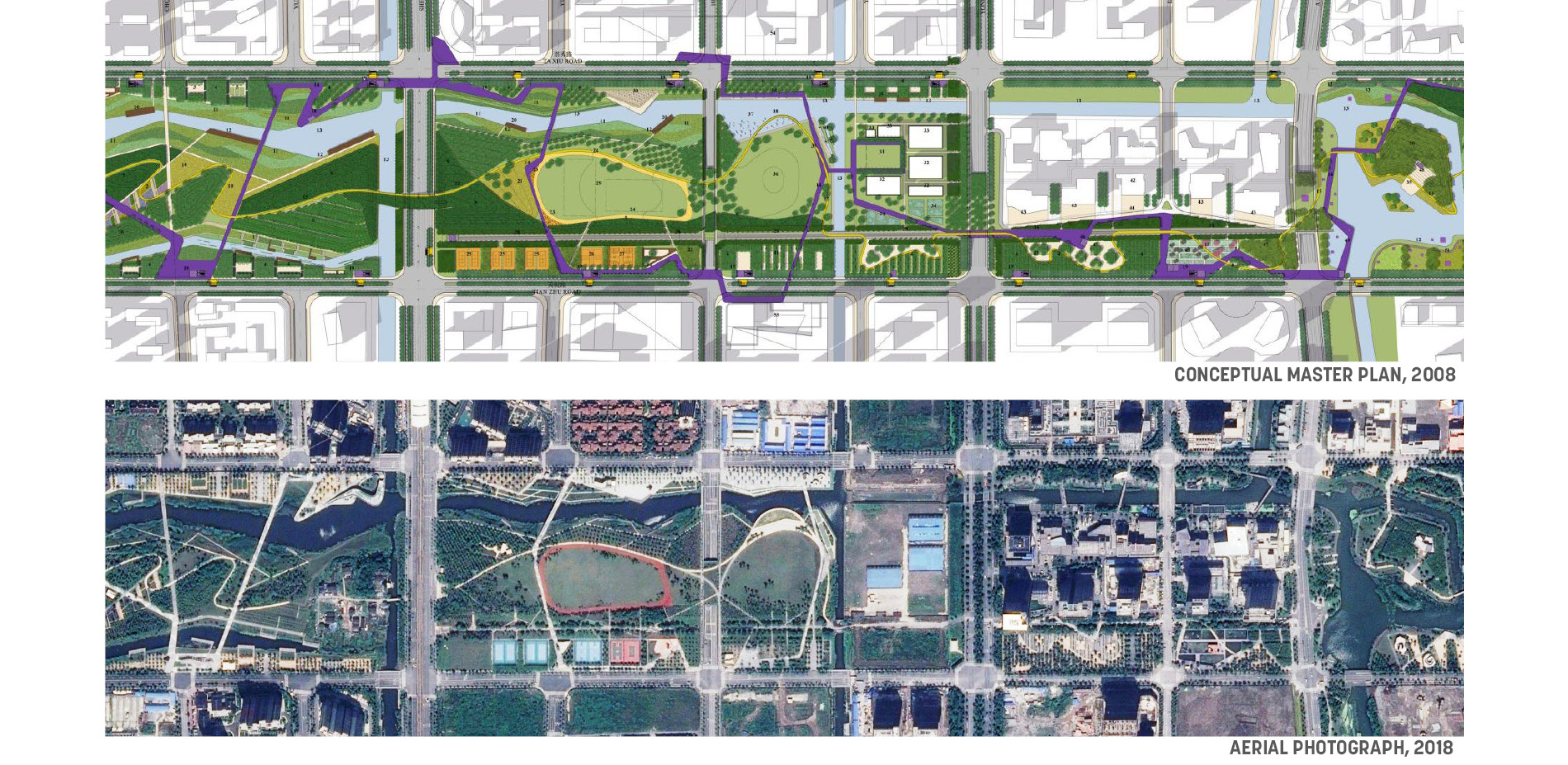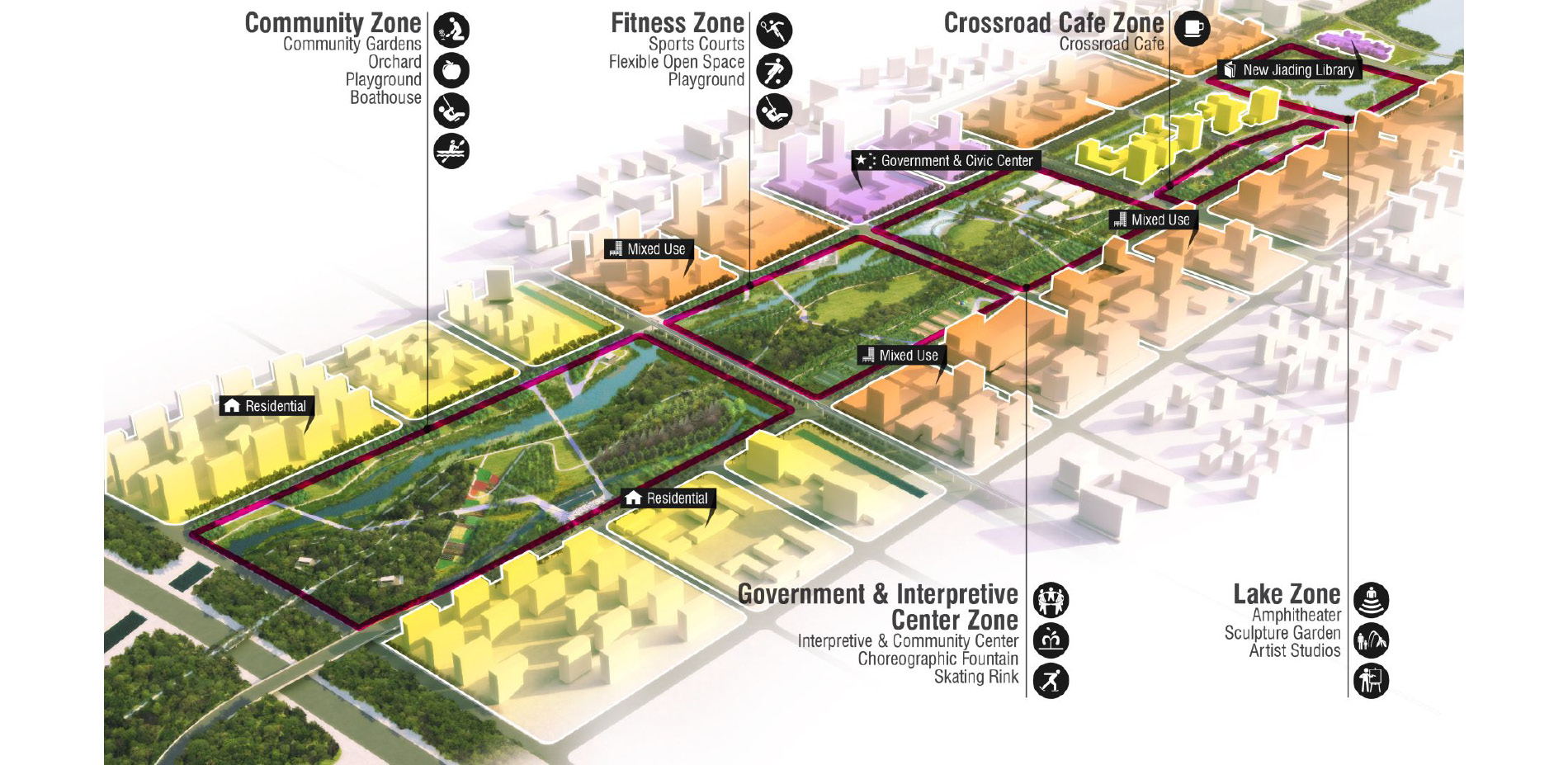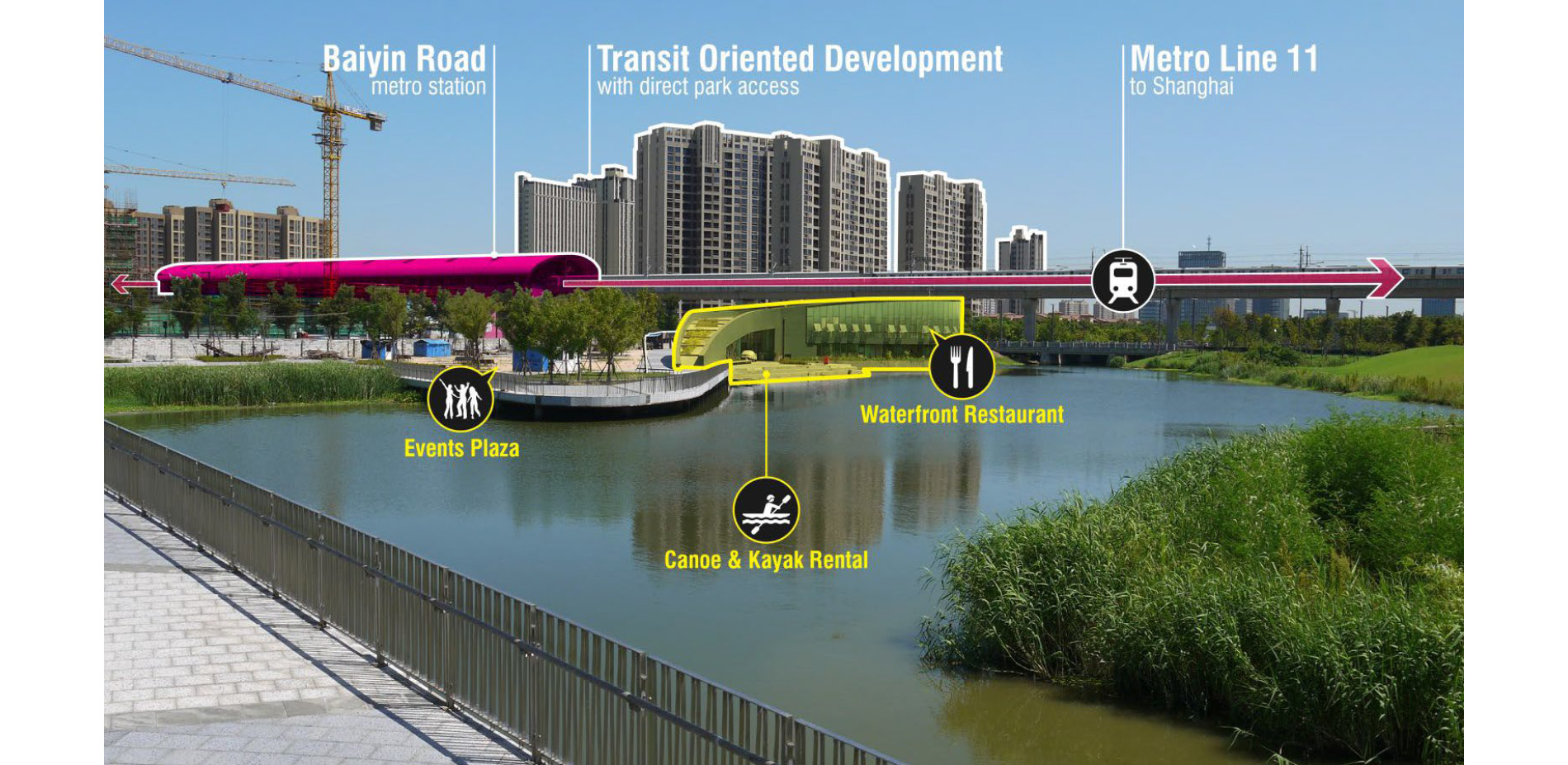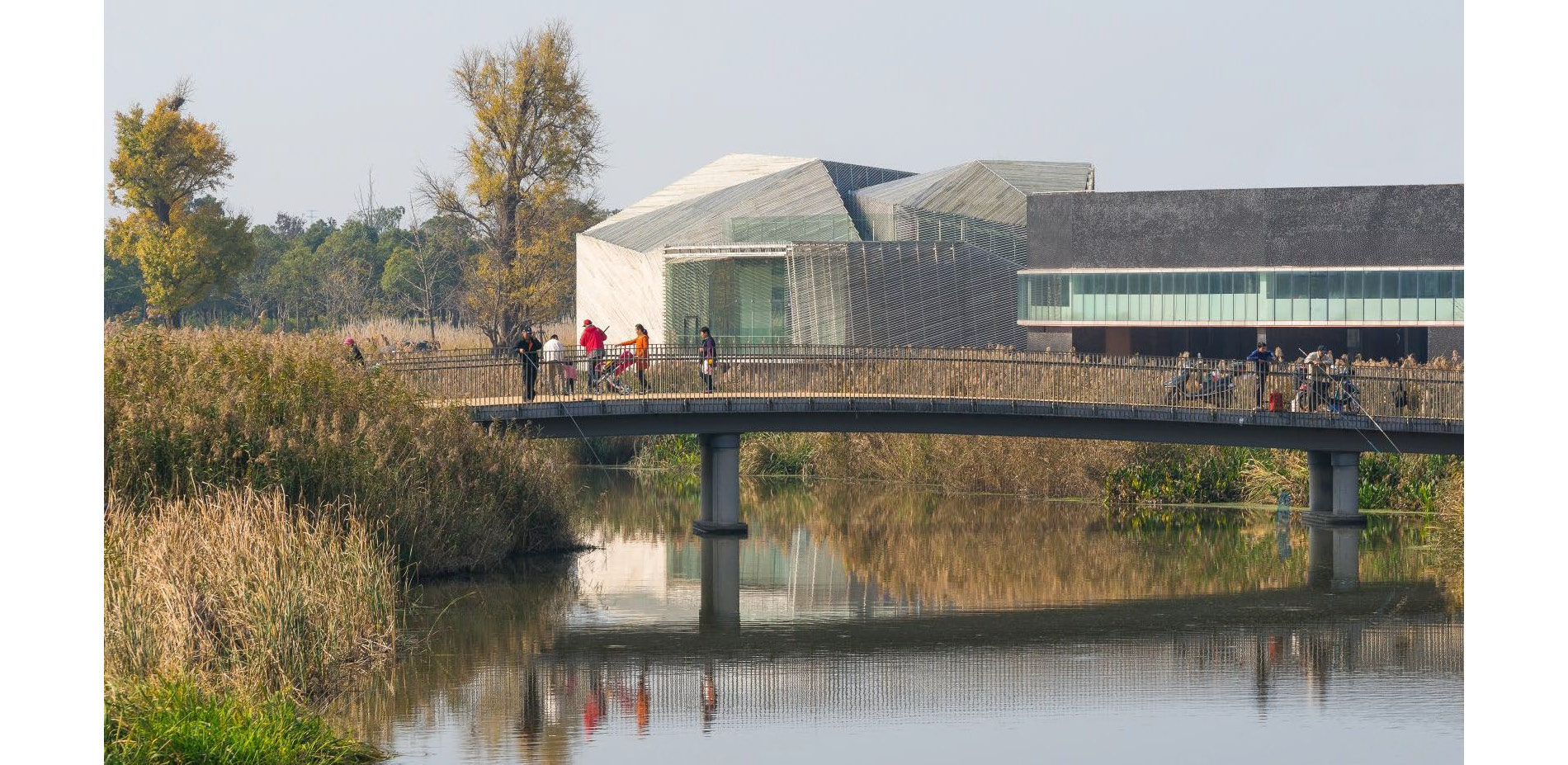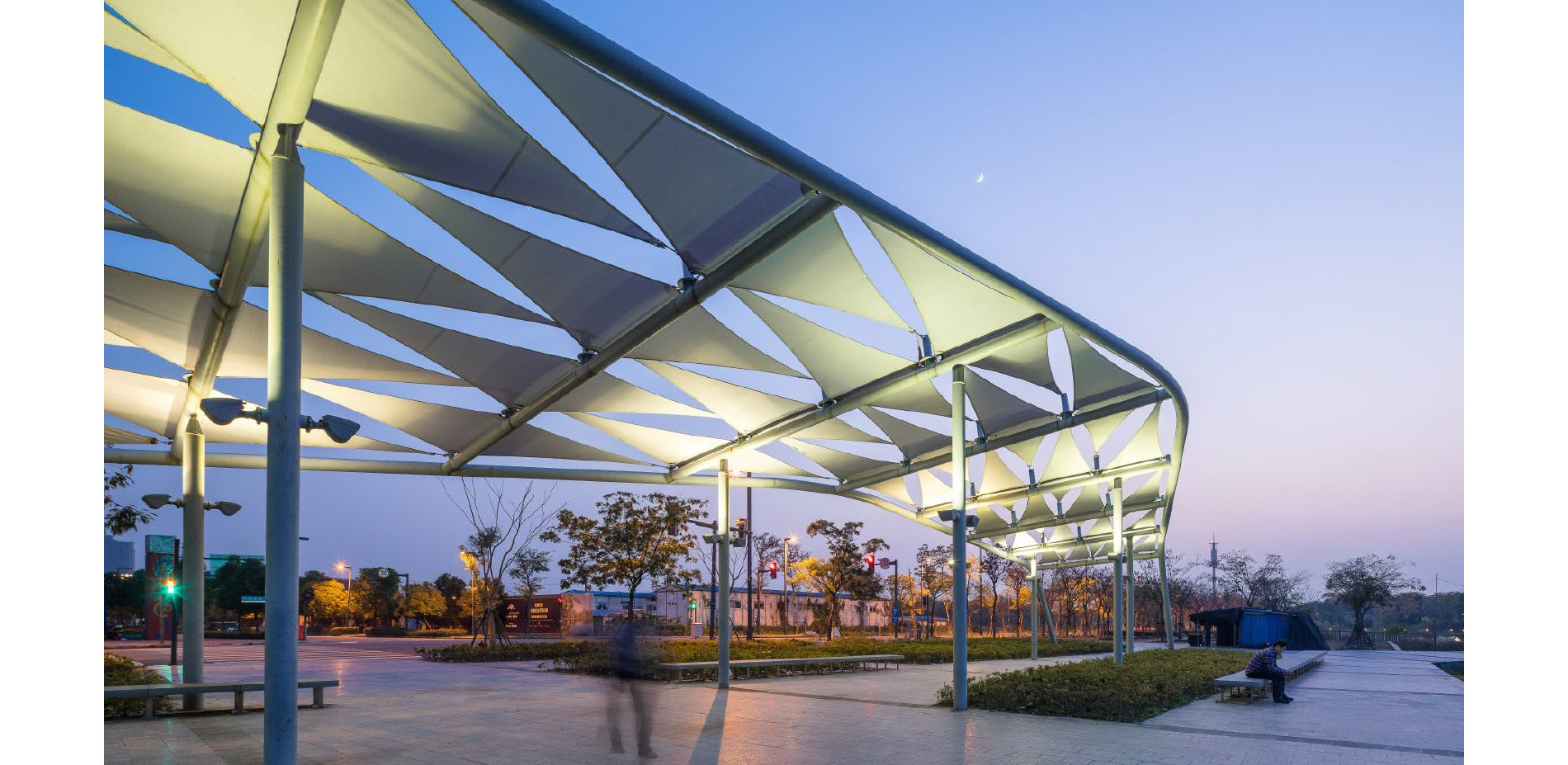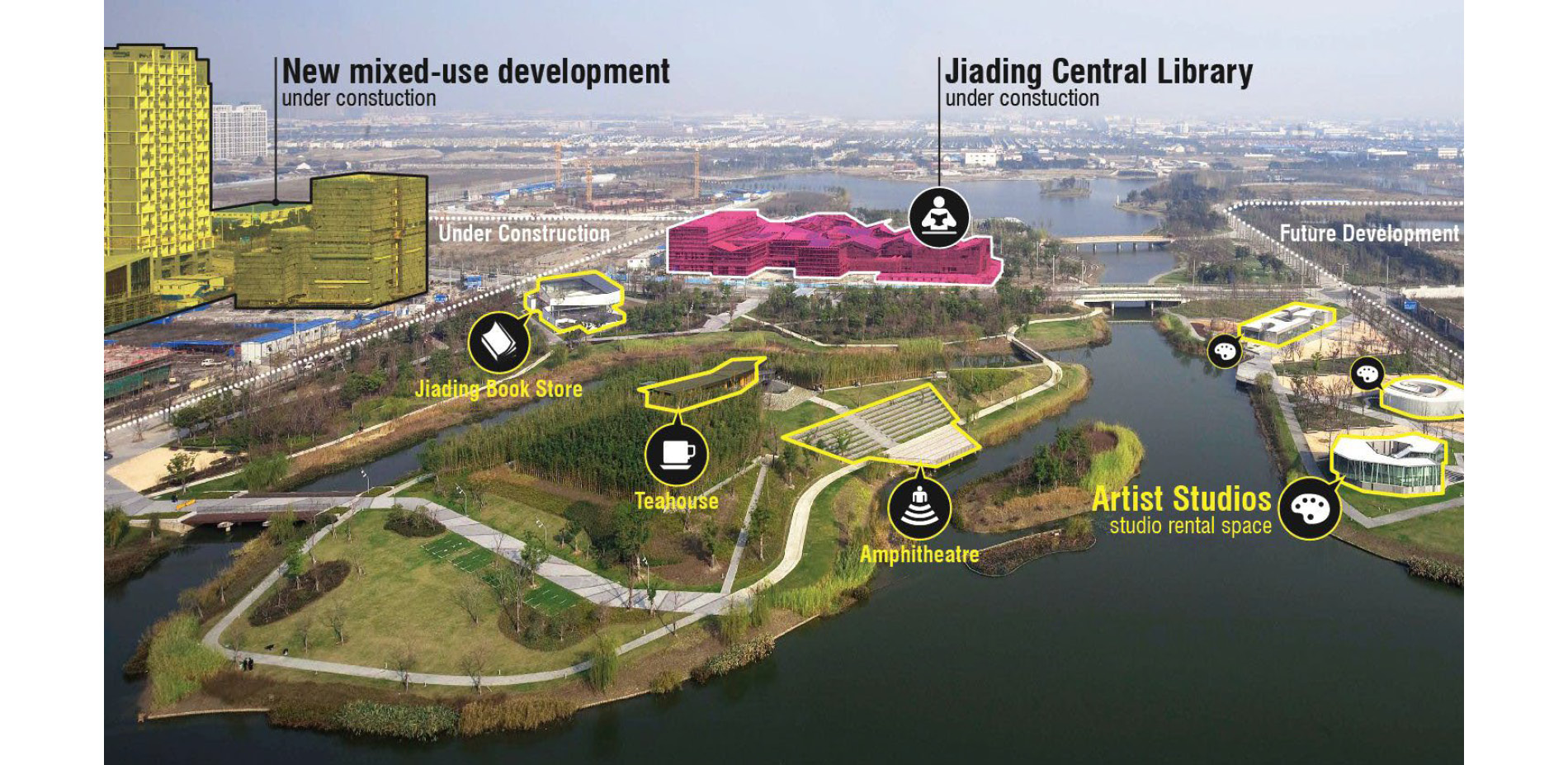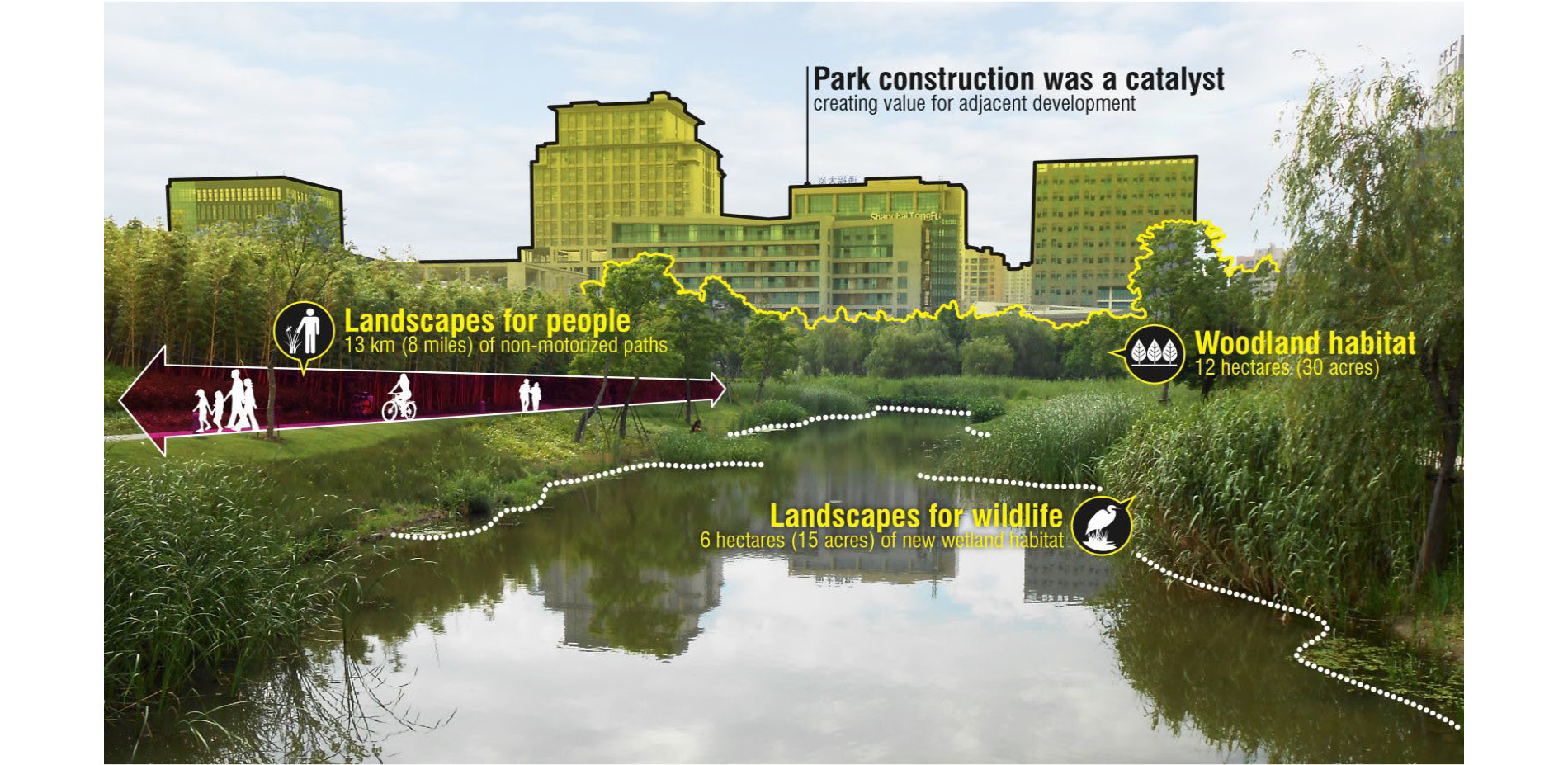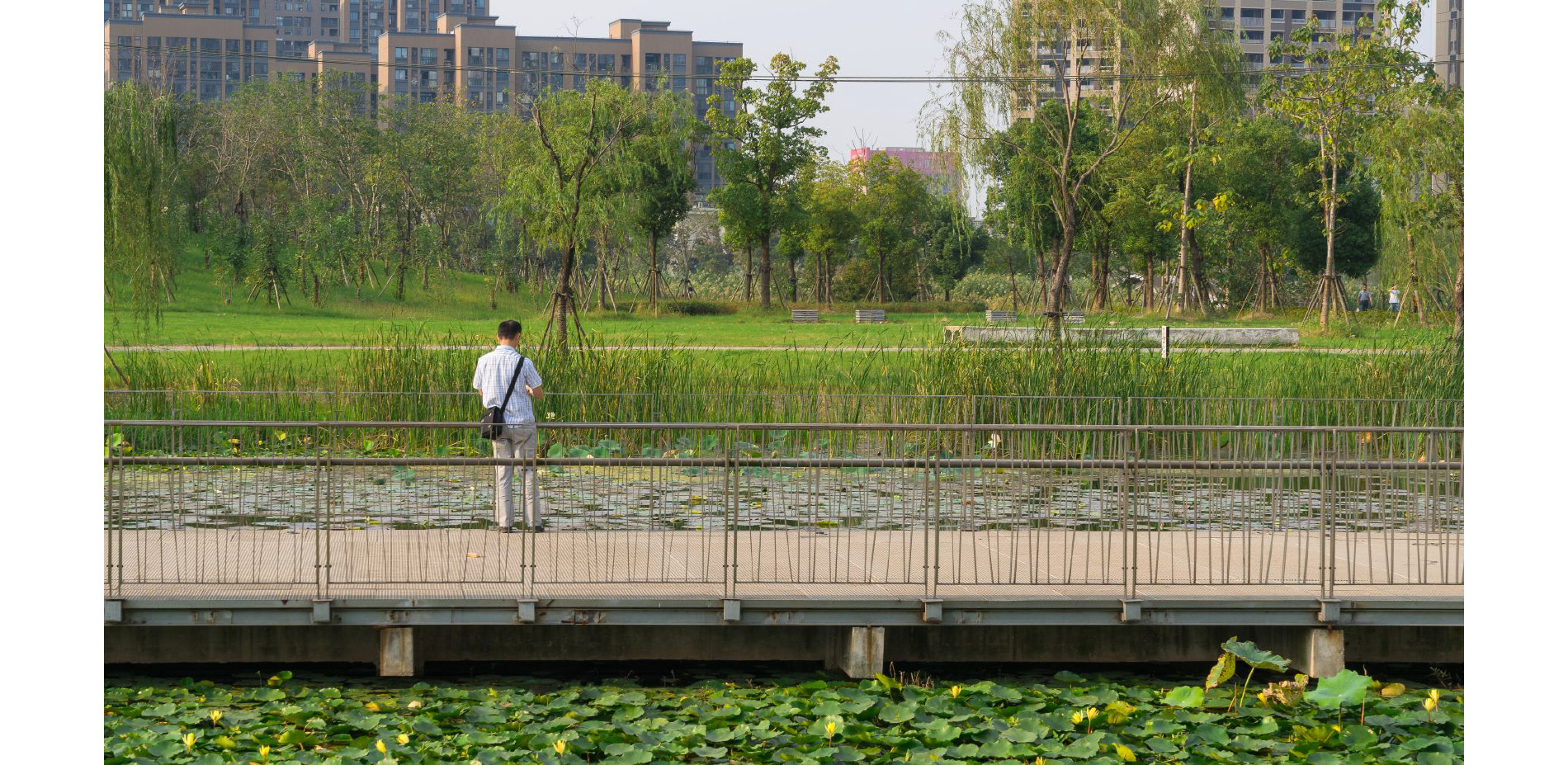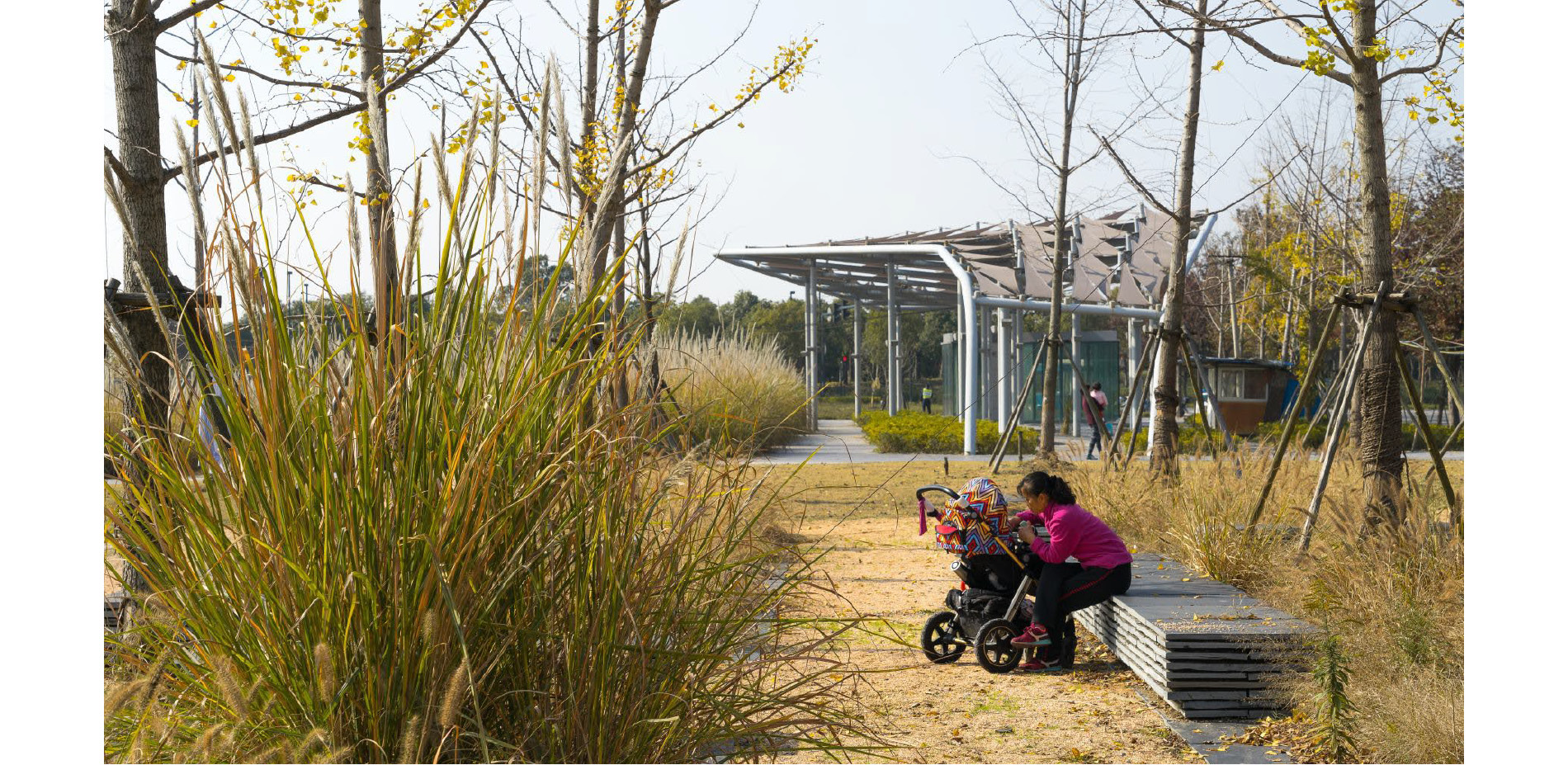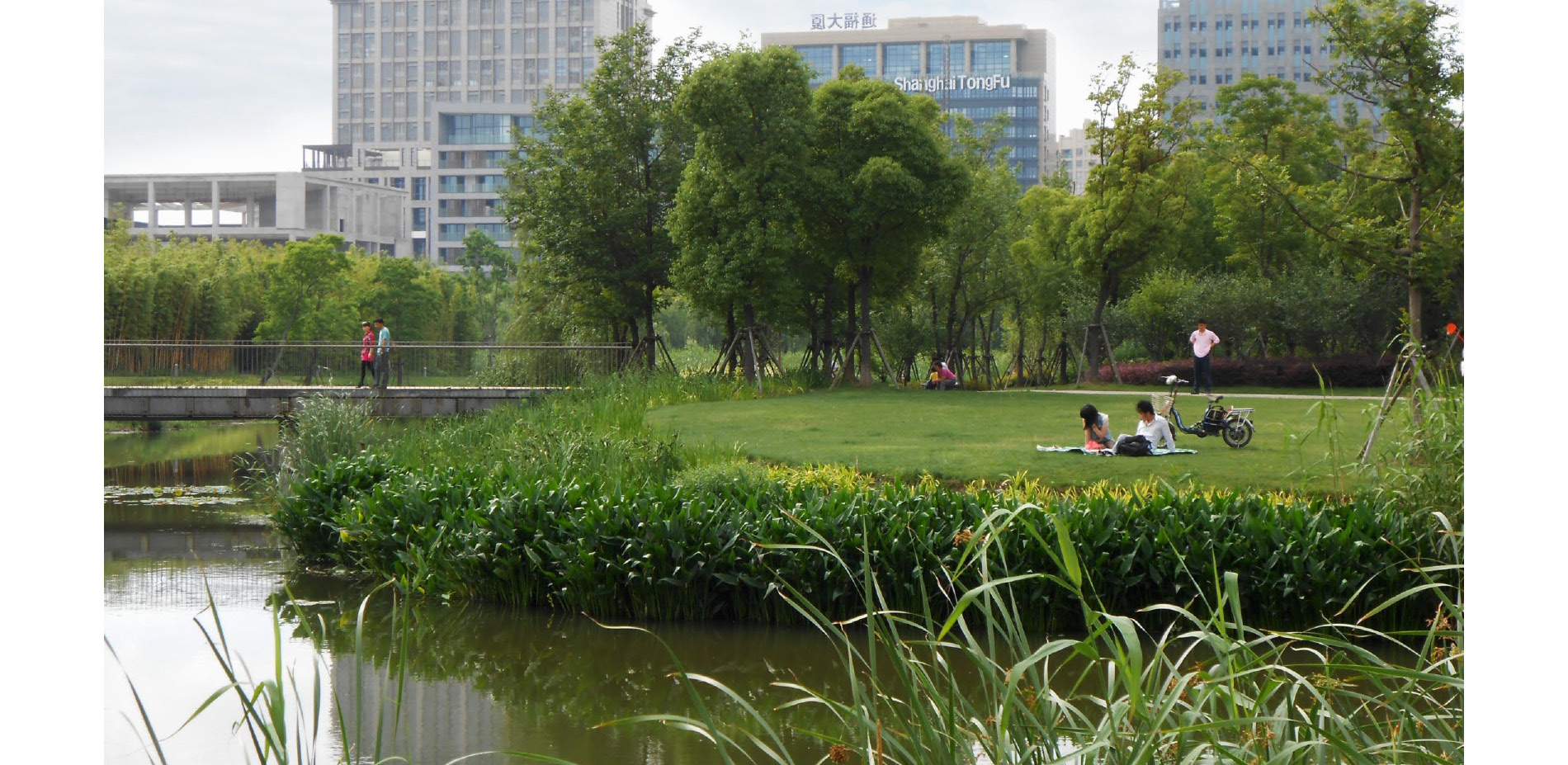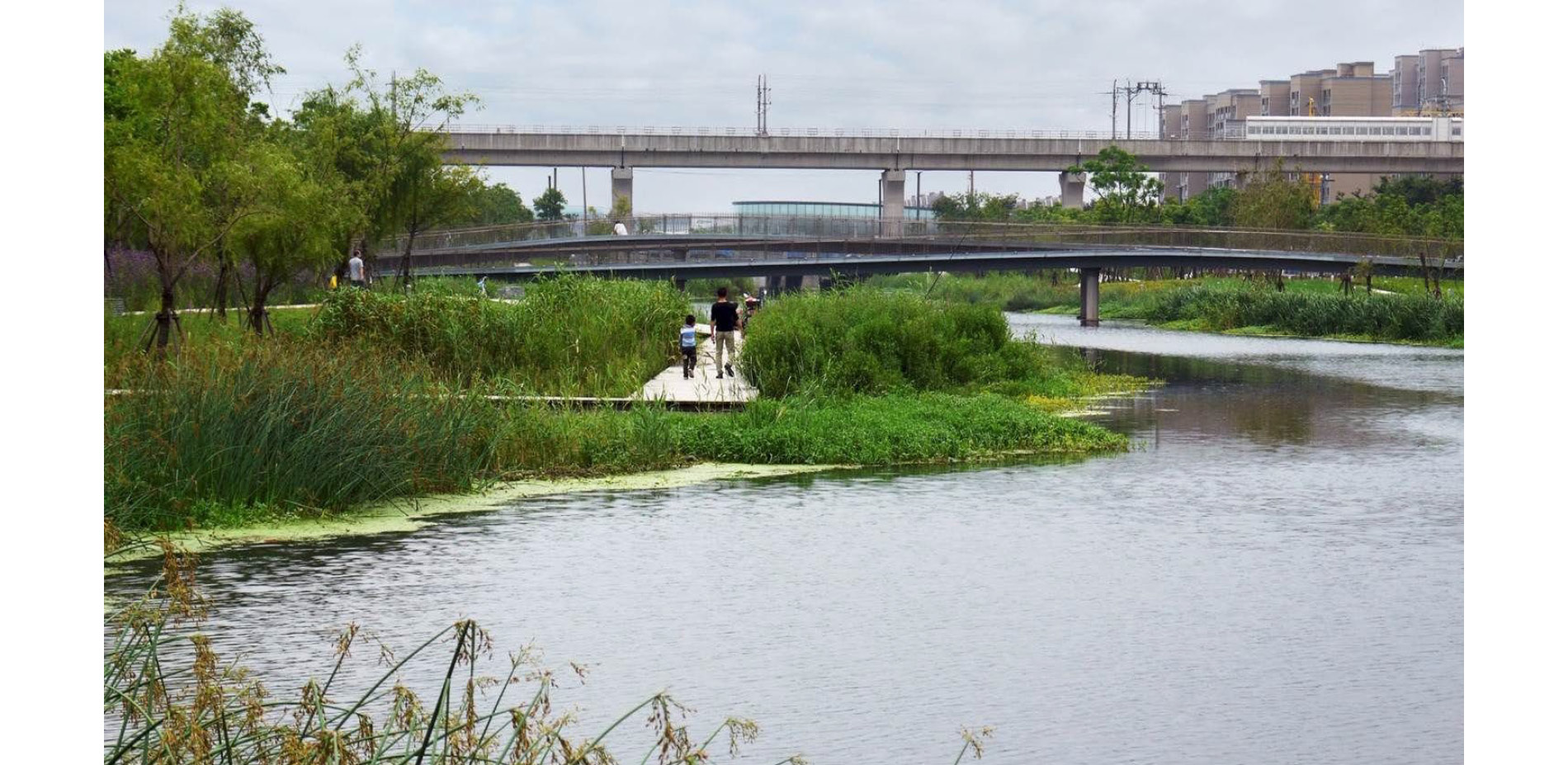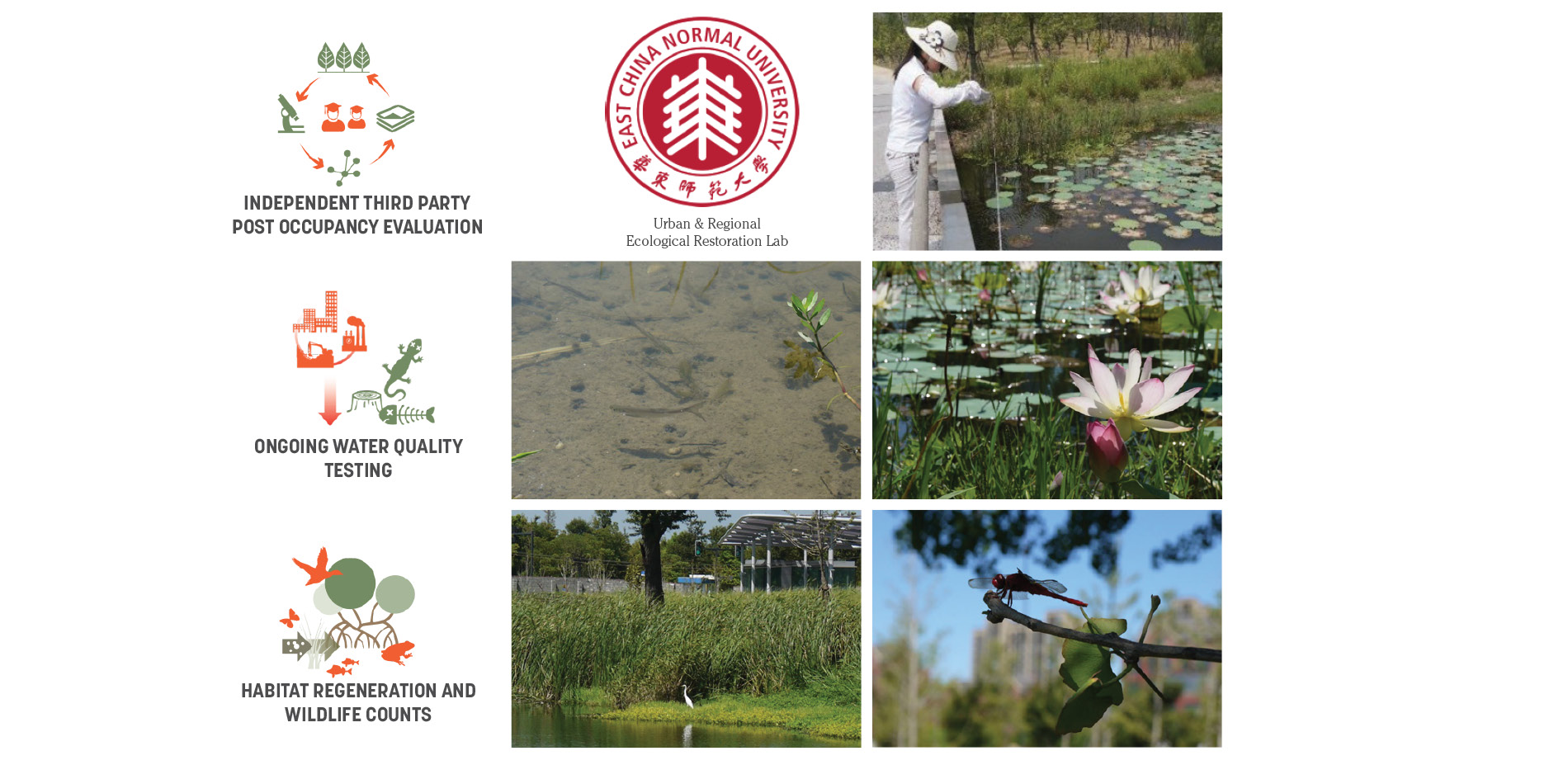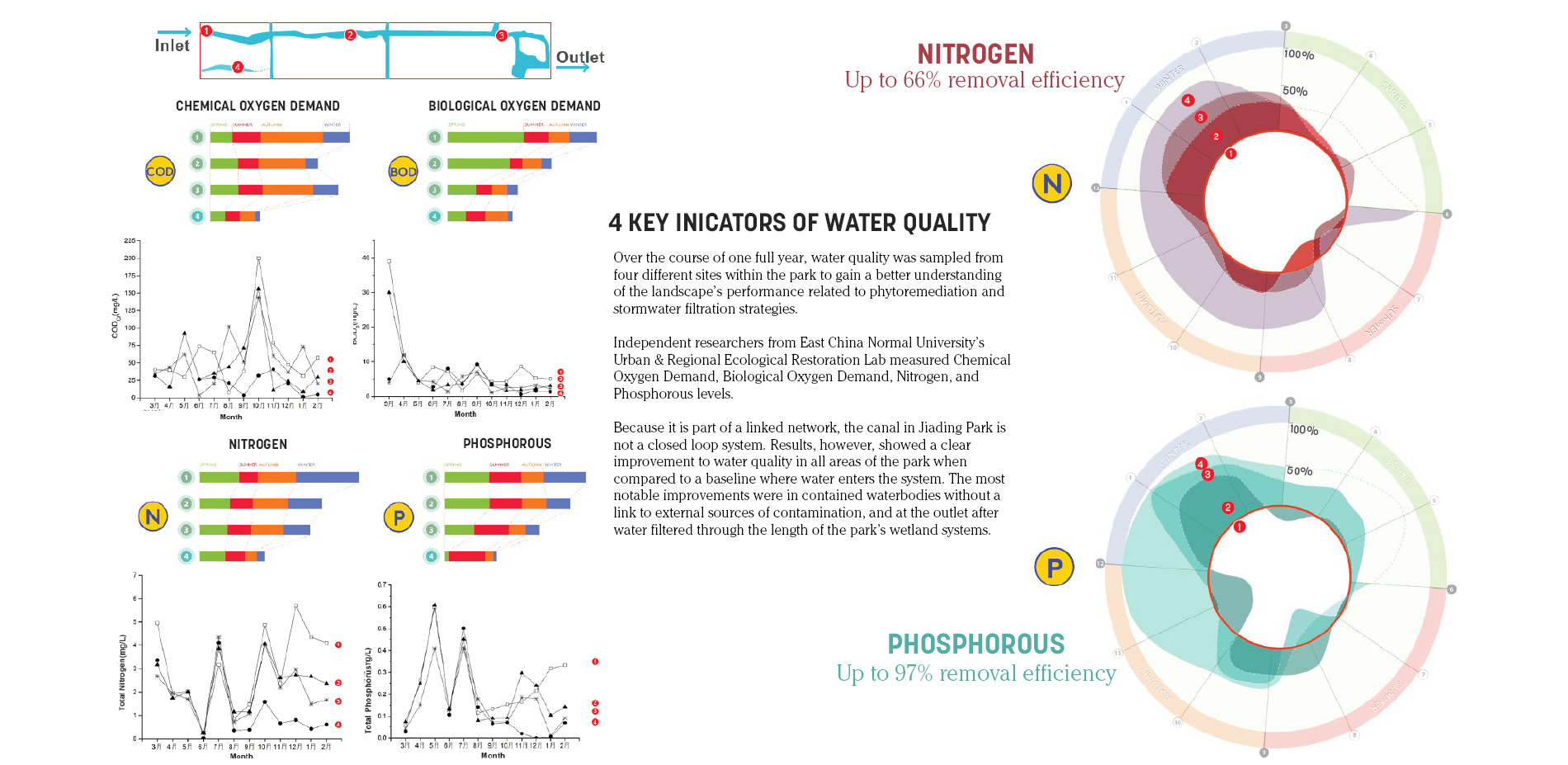Jiading Park
Honor Award
Urban Design
Shanghai, China
SASAKI
Client: Shanghai Jiading New City Development Company, Ltd.
The cleaner air and restorative tranquility of Jiading’s Central Park are crucial selling points for this satellite city of nearby Shanghai. Combining wetland and woodland habitats with areas for recreation and respite across a 70-hectare site, Jiading Park functions as a green lung for the adjacent transit-oriented development. A careful reduction in the number of transverse roadways, and incorporation of pedestrian bridges, allow for overall continuity along roughly eight miles of pathways for non-motorized use. The landscape architects’ strategies of regrading terrain and replanting native species have led canals once clogged with algal bloom to become clear waterways brimming withbiodiversity.
- 2020 Awards Jury
Project Credits
Shanghai Jiading New City Development Co., Owner / Developer
Atelier Archmixing, Architecture
Atelier Deshaus, Architecture
Hanji Architects, Architecture
Scenic Architects, Architecture
Standard Architects, Architecture
CCI Architectural Design, Mechanical & Electrical Engineering
RSE Associates, Structural Engineering
Leni Schwendinger Light Projects, Lighting Consultant
Shanghai Xian Dai Architectural Decoration Landscape Design Research Institute , Local Lighting Consultant
Fluidity Design Consultants, Fountain Design Consultant
Shanghai Lida Fountain Equipment Company, Local Fountain Consultant
Shanghai Garden Construction Co., Ltd., Contractor
Jiading New City Development Company; Jiading Open Space Bureau; Malu Town, Operator
East China Normal University Urban & Regional Ecological Restoration Lab, Post Occupancy Research
Project Statement
Urban expansion is impacting nearly every city in Asia. When limits of density and space are reached, planners and designers are confronted with the question of how peri-urban areas can be co-opted to augment the city center. Jiading, a high-density mixed-use district on the outskirts of Shanghai with a population of 155,000 people, is a prime example. The satellite of a major metropolis, it is marketed as a neighborhood with fewer crowds, better amenities, and a healthier environment. Bolstering its case for livability is the 70 hectare (173 acre) Jiading Park, which was envisioned as the catalyst for the district’s growth and built prior to the surrounding development. Today, Jiading Park is a beloved open space in this rapidly expanding precinct and is at the core of Jiading District’s identity and ethos.
Project Narrative
A NEW URBAN DISTRICT BORNE FROM A PARK
The initial design brief for Jiading Park called for a radical transformation. In its existing state, the site was comprised of factories, warehouses, and fallow agricultural fields. Canals showed signs of eutrophication – the presence of excessive amounts of nutrients – causing an explosion of algal blooms and posing a public health hazard. The new park would have to not only reverse the negatives, but in turn reposition the site into a significant recreational space and lifestyle amenity. To do this, the landscape architects expanded the agenda to include an in depth review of the urban design of the entire district, as well as a comprehensive study of the site’s ecological systems. The goal was to conceive an immersive biophilic experience where natural capital could be restored.
The City’s initial urban design strategy for Jiading District identified an open space reserved for the new park that was segmented into 10 sections with 9 roads cutting across its width. A thorough traffic study initiated by the landscape architect analyzed vehicular flow throughout the entire district and concluded that there would be no significant impact to traffic from eliminating five proposed crossings. Three of the bisecting roadways remain at grade, with one creatively manipulating topography to lower the road slightly to allow for a land bridge. The result was minimized fragmentation of the park, an uninterrupted pedestrian experience, and better connectivity of ecological systems and wildlife corridors.
A 3.2 linear kilometer naturalized canal forms the backbone of the park. Here, wetlands improve water quality and support riparian habitats. Pockets of dense green cover, some inaccessible to humans, create refuge for wildlife. In total, water bodies make up 16.4% of the park while wetlands constitute some 9.2%. Pedestrian and cycling networks are overlaid onto this blue-green canvas, offering visitors options including secluded trails and broad promenades. These two big moves – altering the roadway grid and focusing on its ecological contribution – allowed the park to guide major urban design moves rather than simply reacting to given conditions.
NATURAL SYSTEMS
Existing canals on the site were retained, naturalized, and expanded to improve water quality and filter stormwater runoff. 60,700 square meters of constructed wetlands were created with a capacity to treat up to 10,900 cubic meters, exceeding the runoff volume from the site and surrounding roads and development that drain to the canals during a 95th percentile storm event. Biofiltration areas were included along adjacent roads to provide treatment prior to discharge into the park’s canals. A series of vegetated filter strips supplement the wetlands’ cleansing function, and sub-surface rainwater storage cisterns hold water for irrigation. A post-occupancy evaluation conducted by East China Normal University’s Urban & Rural Ecological Restoration Lab noted significant improvements in water quality across the site. Samples taken at multiple points along the main canal over the course of a full year demonstrated a 66% reduction of total nitrogen, and a 97% reduction of total phosphorous.
The park offers a range of green cover from woodlands, wetlands, tree groves, and lawn areas. Naturalized woodlands comprise 14.4% of the total site area, tree groves comprise 17%, and lawns only around 5%. All vegetation introduced into the park is native to the lower Yangtze River Delta region. Approximately 2,500 existing trees on site were retained, with another 11,474 newly planted. In the final tally, there are some 62 species of trees throughout the park. The planting strategy focused on creating multiple canopy layers and contiguous forest cover, with varying vegetation density. Human accessibility is restricted in some parts, provided critical space for wildlife refuge.
Upon completion of the park, fauna returned to the site at a remarkable rate. Pollinator species, not observed during initial site inventories, have bloomed and fish and amphibian communities have begun to thrive. Although no formal audit was undertaken, the park is anecdotally known to be home to many species of egrets, frogs, dragonflies, crayfish, birds, and fish. Some appear to have transferred from habitats near Yuanxiang Lake to the east.
Also recorded in the post occupancy study conducted by East China Normal University, the park has had an impact on Jiading District’s urban heat island, with a reduction in park surface temperatures averaging 1.9 degrees Celsius. Estimates also suggest that approximately 167 tons of carbon will be sequestered annually in the park, up from a pre-development baseline of 39 tons. Carbon stored over 25 years will equal roughly 2,410 tons, up from 559 tons.
URBAN SYSTEMS
Jiading Park is the social and recreational hub of the burgeoning district, and is connected to a wider network of pedestrian pathways. In total, about 18 hectares of the park are dedicated to recreational uses. About 6,500 square meters of development area features restaurants, art galleries, and civic program. There are also 17 kilometers of paths and boardwalks throughout the park, with links from adjacent residential neighborhoods at multiple points to facilitate accessibility. As a catalyst for the new development, it is now framed by government, cultural, and civic buildings, mixed-use developments, and residential high-rises. It is also highly connected to the regional public transit network, with the Baiyun Road station of the Shanghai metro linking the park to downtown Shanghai in approximately 45 minutes via subway Line 11.
PEOPLE & COMMUNITY
Four distinct pathways run the length of Jiading Park – the Dynamic Path, the Tranquil Path, the Water Path, and the Tree Path. The Water Path runs alongside the main canal, past wetlands, filtration beds, planted wetland terraces, and waterfront boardwalks. The Dynamic Path links activity nodes with broad promenades and trails that climb topography and frame views of the site and city. The Tranquil Path is narrower and meanders through denser vegetation, allowing for a more immersive experience. Finally, the Tree Path was constructed by recycling the asphalt of a former road and utilizes its existing street trees to provide a shaded promenade. According to a recent social survey conducted by a research team from the National University of Singapore (NUS), most visitors are 25-40 years old and frequent the park with their families. The majority walk or bike to the park from less than a 2 kilometer radius, and many enjoy fishing in the canal in addition to the park’s programmed amenities. NUS researchers also noted that the park is the epicenter of public space and social life in the Jiading neighborhood and acts as a magnet not only for the residents of the area, but also for those considering a move out of Shanghai.
IMPACT
Since its opening, Jiading Park, has become the geographic and symbolic center of Jiading District. It makes suburban living feel more urban, yet promises a better lifestyle and a sustainable environment. More critically, it showcases nature-centric planning as a viable, lucrative model for urban expansion. The design process battled skepticism from the start, as conventional mindsets clashed with forward-thinking outlooks. Typically, Chinese parks are manicured and monocultural. By comparison, Jiading Park is untamed in appearance and intentionally complex. The design team invested their political capital in educating the client and local stakeholders on how the proposed ecosystems approach would be a differentiator. This trust-building process was pivotal in the eventual success of the project.
The goal to decongest cities like Shanghai depends on how satellite districts like Jiading bring nature back into its postindustrial landscapes. Its park was one of the first large developments of its kind in China to adopt an ecological approach to landscape design, before policies on “Sponge Cities” were adopted. Today, Jiading Park stands as a prime example of the impact restorative strategies can have, particularly on improvements to water quality the proliferation of wildlife habitats.
Products
- Shanghai Zhongsu Piping Company, Ltd.
- Rainbird Irrigation Equipment (Shanghai) Company, Ltd.
- Flexlight Advanced Membrane
- Serge Ferrari
- ountain Equipment and Underground Stormwater Retention Cistern; Shanghai Lida Fountain and Irrigation Equipment Company, Ltd.
- Precast Concrete Pavers with Glass Aggregate; Shanghai MCC Environmental Engineering Technology Company, Ltd.
- Zhejiang Goody Lighting Technology Co. Ltd.
Plant List:
- Aesculus chinensis Bunge (Chinese horse chestnut)
- Bischofia polycarpa (Bishop wood)
- Celtis sinensis (Chinese hackberry)
- Cercis chinensis (Chinese redbud)
- Cinnamomum camphora (Camphor tree)
- Koelreuteria paniculata (Goldenrain tree)
- Lagerstroemia indica (Crape myrtle)
- Liriodendron chinense (Chinese tulip tree)
- Magnolia liliflora Desr. (Mulan magnolia)
- Melia azadirachta (Syringa berrytree)
- Pterocarya stenoptera (Chinese wingnut)
- Quercus variablilis Blume. (Chinese Cork Oak)
- Salix babylonica (Weeping willow)
- Sapindus mukorossi (Soap nut)
- Sapium sebiferum (Chinese tallow tree)
- Toona sinensis (Chinese toon)
- Zelkova schneideriana (Schneider zelkova)
- Buddleja lindleyana (Butterfly bush)
- Buxus bodinieri Levl. (Boxwood)
- Euonymus fortunei (Fortune's spindle)
- Forsythia viridissima Lindl. (Goldenbells)
- Gardenia jasminoides (Common gardenia)
- Hypericum chinense (Chinese St. John's wort)
- Ligustrum quihoui Carr. (Quihou privet)
- Loropetalum chinense 'Razzleberri' (Chinense razzleberry)
- Photinia fraseri ‘Red Robin’ (Photinia)
- Rhododendron mariae Hance (Rhododendron mariae)
- Rhododendron mucronatum G. Don. (Rhododendron)
- Rhododendron pulchrum (Shirotae Azalea)
- Vitex trifolia Linn. Var. simplicifolia Cham. (Simpleleaf chastetree)
- Cynodon dactylon (Bermuda grass)
- Liriope platyphylla (Wide-leaf monkey grass)
- Ophiopogon japonicus (Mondo grass)
- Orychophragumus violaceus Scirpus (Chinese violet cress)
- Renieckea Carnea (Reineckea)
- Acorus gramineus 'Ogon' (Japanese rush)
- Iris lactea (Beardless iris)
- Lytrhus salicaria L. (Purple loosestrife)
- Typha angustifolia Linn. (Lesser Cattail)
- Zizania latifolia (Manchurian wild rice)
